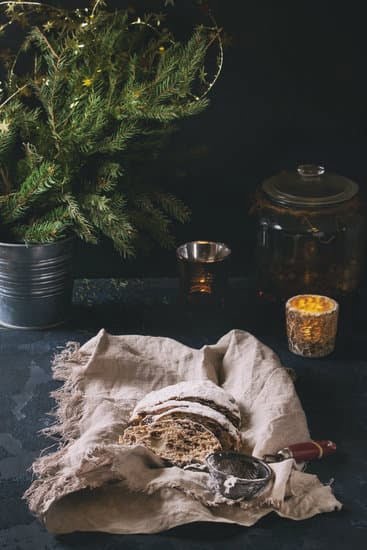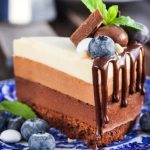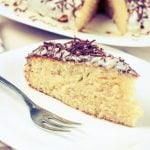Decorating cakes can be a delightful and creative process, allowing us to showcase our baking skills and bring joy to others. However, one of the most frustrating obstacles in achieving a pristine cake design is dealing with crumbs. Just when we think we’ve achieved a smooth finish, pesky little crumbs seem to appear out of nowhere, ruining our efforts. That’s why finding a cake decorating solution for no crumbs left is essential for creating flawless masterpieces.
Imagine spending hours carefully slicing and stacking layers of moist cake only to have crumbs interfere with the final presentation. It can be incredibly disheartening to see these unwanted specks turn what should be a visually stunning creation into something messy and imperfect. The good news is that there are methods and techniques that can help minimize or even eliminate crumbs during the decorating process.
Understanding the root causes of crumb issues is crucial for identifying effective solutions. Common culprits include the way we slice the cake, apply the crumb coat, and spread frosting onto the surface. Each step presents an opportunity for those tiny bits of cake to cling onto the icing and ruin our desired result.
To achieve that wow-factor finish we all desire, it’s imperative that we address this problem head-on. Whether you’re an aspiring baker or seasoned decorator, learning how to combat crumbs is essential for taking your cake creations to the next level.
By implementing specific strategies and utilizing appropriate tools, such as offset spatulas, bench scrapers, and cake combs, you can significantly reduce or eliminate crumbs during the decorating process. Additionally, exploring various techniques like freezing cake layers before decorating or using Viva paper towel method can go a long way in minimizing crumb interference.
With patience and practice along with helpful tips shared in this article, you’ll soon discover how effortless it can be to achieve a flawless finish without any pesky crumbs left behind on your beautifully decorated cakes.
Understanding the Problem
When it comes to cake decorating, dealing with crumbs can be a frustrating challenge. Even the most skilled decorators have come across this issue at some point. Understanding the common causes of crumbs during cake decorating can help address this problem more effectively.
One common cause of crumbs is cake slicing. When cutting a cake into layers, it is important to use a sharp knife or a cake leveler while applying gentle and even pressure. This will help create clean and smooth layers with minimal crumbs. It’s also crucial to wait until the cake has completely cooled before slicing it, as warm cakes tend to crumble more easily.
Another culprit for crumbs during cake decorating is the application of the crumb coat. A crumb coat is a thin layer of frosting that acts as a base before applying the final layer of frosting. It helps seal in any loose crumbs and provides a smooth canvas for decoration. When applying the crumb coat, it’s essential to use a light touch and avoid dragging the spatula too forcefully against the cake surface to prevent excessive crumbling.
Lastly, frosting techniques can also contribute to the presence of crumbs in decorated cakes. Spreading frosting too vigorously or using an inadequate spreading tool can cause crumbs to lift from the surface of the cake and mix into the icing. To minimize this issue, decorators should opt for offset spatulas or bench scrapers that allow for smoother and more controlled movements when spreading frosting.
Understanding these common causes of crumbs during cake decorating is crucial in finding effective solutions for achieving flawless finishes on cakes. By addressing these issues through proper slicing techniques, careful application of a crumb coat, and mindful frosting methods, decorators can significantly reduce unwanted crumbs in their creations.
| Common Causes | Solutions |
|---|---|
| Cake Slicing | Use a sharp knife or cake leveler, apply gentle and even pressure, and wait for the cake to cool completely before slicing. |
| Crumb Coat Application | Apply the crumb coat with a light touch, avoid dragging the spatula forcefully against the cake surface. |
| Frosting Techniques | Use an offset spatula or bench scraper for smoother and controlled movements when spreading frosting. |
The Importance of a Crumb Coat
A crumb coat is a thin layer of frosting or icing that is applied to the cake before the final layer of decoration. The purpose of a crumb coat is to seal in any loose crumbs and create a smooth surface for the final layer of frosting or icing. It acts as a barrier that helps prevent crumbs from mixing into the final design, ensuring a clean and professional finish.
To apply a crumb coat effectively, start by leveling your cake with a serrated knife to create an even surface. Then, place a generous amount of frosting on top of the cake and use an offset spatula to spread it evenly over the sides and top. Make sure to cover all areas and fill any gaps or holes.
Once you have applied the crumb coat, refrigerate the cake for about 15-30 minutes. This allows the frosting to firm up and lock in any loose crumbs. After chilling, you can proceed with applying your final layer of frosting or icing without worrying about crumbs interfering with your design.
It’s important to note that the crumb coat doesn’t need to be perfect or perfectly smooth because it will be covered by the final layer of decoration. Its main purpose is to create a smooth base that prevents crumbs from showing through in the finished product. Applying a crumb coat can save time and frustration by eliminating potential issues later on in the decorating process.
Tips for Applying a Crumb Coat
- Use an offset spatula: An offset spatula is designed specifically for spreading icing or frosting smoothly and evenly. It allows you better control when applying the crumb coat, reducing the chances of introducing more crumbs.
- Thin out your frosting: To achieve an even coverage without adding too much bulk, thin out your frosting slightly by adding small amounts of milk or water until it reaches a spreadable consistency.
- Work quickly: Apply your crumb coat efficiently to minimize exposing the cake to air and reducing the risk of crumbs spreading.
- Clean your tools: Before applying the final layer of frosting, make sure to clean your spatula or knife to avoid transferring any crumbs or residue onto the cake.
By taking the time to apply a crumb coat properly, you can save yourself from frustration and ensure a flawless finish for your cake decorations.
Choosing the Right Tools
Cake decorating requires the use of specific tools and equipment that can aid in achieving a crumb-free cake decoration. These tools are designed to help bakers achieve a smooth and flawless finish while minimizing the risk of crumbs ruining the final design. Here are some recommended tools for achieving a crumb-free cake decoration:
- Offset Spatulas: Offset spatulas are essential for spreading frosting or ganache smoothly on the cake surface. Their angled shape allows for better control and precision, minimizing the chances of disturbing any crumbs. They come in various sizes, allowing bakers to choose the one that best suits their needs.
- Bench Scrapers: Bench scrapers are versatile tools that can be used for various purposes during cake decorating. They can be used to level and smooth the sides of a cake, creating sharp edges and preventing crumbs from getting trapped in the frosting. Additionally, bench scrapers can also be used to scrape off excess frosting or ganache, helping to achieve a clean and crumb-free finish.
- Cake Combs: Cake combs are specialized tools with serrated edges that can be used to create decorative patterns on the sides of a cake. Not only do they add texture and visual interest to a cake design, but they also help seal in any loose crumbs that may have been present after applying the crumb coat. Using a cake comb during the frosting process can ensure a smooth final result.
Using these recommended tools, along with proper techniques, can greatly contribute to achieving a crumb-free cake decoration. It is important for bakers to invest in high-quality tools that will last longer and provide better results. With these tools at hand, bakers can have more control over their cake designs and minimize the frustration of dealing with unwanted crumbs.
| Recommended Tools | Description |
|---|---|
| Offset Spatulas | Angled spatulas that aid in smooth frosting or ganache application |
| Bench Scrapers | Versatile tools used for leveling, smoothing, and removing excess frosting or ganache |
| Cake Combs | Specialized tools with serrated edges for creating decorative patterns and sealing in crumbs |
Cake Decorating Techniques for Minimal Crumbs
The Viva Paper Towel Method
One effective technique for minimizing crumbs while decorating a cake is known as the Viva paper towel method. Instead of using a traditional spatula or knife to smooth the frosting, this method utilizes a piece of Viva paper towel to achieve a clean and crumb-free finish. The key is using a brand of paper towel that has no texture or embossing, as these can leave unwanted imprints on the cake.
To use the Viva paper towel method, start by applying a thin layer of frosting to your crumb-coated cake. Next, gently press the paper towel onto the frosted surface and lightly smooth it over the cake, in the direction you want your final design to appear. The texture of the Viva paper towel will help remove any excess crumbs while leaving behind a smooth and polished look.
Freezing Cake Layers Before Decorating
Another technique that can help minimize crumbs during cake decorating is freezing the cake layers before starting the decoration process. By chilling the cakes, they become firmer and less prone to crumbling when you handle them. Freezing also helps lock in moisture, resulting in a moister and more stable cake overall.
To freeze cake layers, allow them to cool completely after baking. Once cooled, wrap each layer tightly in plastic wrap and place them in an airtight container or freezer bag. It’s important to freeze them for at least several hours or overnight before decorating to ensure they are firm enough for handling.
Using a Gentle Touch While Spreading Frosting
When it comes to applying frosting on your cake layers, using a gentle touch is crucial in minimizing any potential crumbs. Avoid pressing too hard or vigorously spreading the frosting across the surface as this can dislodge crumbs from the cake itself.
Instead, hold your spatula or knife at an angle and gently lift and spread the frosting in a smooth motion. Start from the center of the cake and work your way outwards, rotating the turntable as needed for even coverage. By being mindful of your pressure and using a light touch, you’ll be able to achieve a crumb-free base for your final decoration.
Implementing these techniques can significantly reduce the occurrence of crumbs while decorating cakes, leading to a smoother and more professional-looking finish. By utilizing the Viva paper towel method, freezing cake layers before decorating, and using a gentle touch while spreading frosting, you’ll be well on your way to creating stunning cakes with minimal frustration.
Using Ganache as a Crumb-Free Alternative
Ganache is a versatile and delicious alternative to traditional frosting that can help achieve a crumb-free cake decoration. Made from a combination of chocolate and cream, ganache has a smooth and velvety texture that makes it easy to spread over cakes. One of the primary benefits of using ganache is its ability to create a seal on the cake’s surface, preventing any loose crumbs from interfering with the final design.
To use ganache in your cake decoration process, follow these step-by-step instructions:
- Prepare the Ganache: Start by heating heavy cream in a saucepan until it begins to simmer. Remove it from the heat and pour it over finely chopped chocolate in a separate bowl. Let it sit for a few minutes to allow the chocolate to melt, then stir until it becomes smooth and glossy.
- Let Ganache Cool: After preparing the ganache, let it cool at room temperature until it thickens slightly but is still pourable. This will ensure that it spreads smoothly over the cake without becoming too runny.
- Apply Ganache as a Base Coat: Once cooled, pour or spread the ganache over the cake with an offset spatula or icing smoother. Ensure that you cover every surface evenly and smoothly.
- Chill and Set: After applying the ganache, refrigerate the cake for about 20-30 minutes, or until the ganache sets and becomes firm to touch.
- Apply Final Coat of Ganache: Once the base coat has set, apply another layer of ganache over the initial coat using smooth strokes of an offset spatula or icing smoother. This second layer will provide additional coverage and create a flawless finish.
By using ganache as an alternative to traditional frosting, you can achieve a crumb-free cake decoration that will impress your guests. The smooth texture and ability to seal in any loose crumbs make ganache an excellent choice for achieving a flawless finish. Experiment with different flavors of chocolate and explore various techniques for applying ganache to create unique designs on your cakes.
Tips and Tricks for a Crumb-Free Cake
To achieve a crumb-free cake decoration, there are several additional tips and tricks that can be utilized. These suggestions will help ensure that your cake turns out flawlessly, without any unwanted crumbs.
Firstly, it is recommended to chill the cake layers before frosting them. This helps to firm up the cake, making it less likely to crumble or produce excess crumbs during the frosting process. Place the cakes in the refrigerator for at least 30 minutes before beginning the decoration process.
Another helpful tip is to use a long, clean knife while cutting the cake. This ensures clean and precise slices without causing excessive crumbling. A long knife allows you to cut through the cake in one smooth motion, minimizing any chances of creating loose crumbs.
One key aspect of achieving a crumb-free cake decoration is patience. It’s important to take your time while spreading frosting, as a rushed or aggressive approach can lead to more crumbs. Use gentle motions with an offset spatula or a bench scraper to spread the frosting smoothly over the cake surface.
In addition to these tips, here are a few other tricks that can further assist in achieving a crumb-free cake decoration:
- Do not apply too much pressure while spreading or smoothing the frosting as this can cause crumbs.
- If you notice any loose crumbs on the surface of your frosted cake, gently remove them with a small brush or by lightly patting them with a clean paper towel.
- When applying successive layers of frosting, make sure each layer has fully chilled and set before adding another layer.
- Consider using buttercream icing instead of whipped cream as it tends to be firmer and less likely to produce crumbs.
- Avoid overly intricate designs or decorations that may disturb the surface of the cake and cause crumbs.
By implementing these tips and tricks, you’ll have a better chance of achieving a crumb-free finish on your decorated cakes. Remember that practice makes perfect, so don’t get discouraged if you encounter a few crumbs along the way. With time and experience, you’ll become a pro at creating flawlessly decorated cakes.
Troubleshooting
While striving for a crumb-free cake decoration, it is not uncommon to encounter certain challenges and setbacks along the way. One of the most frustrating issues faced by cake decorators is the crumbling of the cake while frosting. This can result in an uneven appearance and compromised texture. However, with a few simple tips and tricks, it is possible to overcome these obstacles and achieve a flawless finish.
One quick solution to prevent cake crumbling while frosting is to ensure that your cake layers are properly chilled before beginning the decorating process. Chilling the layers helps firm up the cake, making it less likely to crumble under pressure. Place your cakes in the refrigerator for at least two hours or overnight before frosting them. Additionally, freezing the layers briefly can also assist in minimizing crumbs during frosting.
Another helpful technique when dealing with crumbing cakes is using a long, clean knife while cutting the cake into layers or shapes. A serrated knife usually works best for this purpose as it cuts through the cake smoothly without causing excessive crumbs. It is important to clean the knife after each cut to avoid spreading crumbs onto subsequent layers or parts of the cake.
Patience is key when it comes to achieving a crumb-free cake decoration. Avoid rushing through the frosting process as haste can lead to more crumbs. Instead, take your time spreading the icing gently and evenly over each layer of cake. Using an offset spatula can be particularly helpful in ensuring a smooth application without disturbing too many crumbs.
Remember that even with careful techniques, some minor crumbs may still find their way onto your finished creation. Do not despair if this happens; there are ways to fix it. One quick solution for removing unwanted crumbs from frosted cakes is using a bench scraper or a cake comb. Simply run either tool gently along the sides and/or top of the cake, removing any stray crumbs as you go.
By employing these troubleshooting techniques and solutions, you can overcome common challenges like cake crumbling while frosting and achieve a crumb-free cake decoration. With practice and patience, you will soon be able to consistently create flawless, professional-looking cakes that are sure to impress.
Conclusion
In conclusion, dealing with crumbs while decorating cakes can be a frustrating experience, but it doesn’t have to ruin your final cake design. Throughout this article, we have explored various solutions and techniques for achieving a flawless, crumb-free finish.
We started by understanding the common causes of crumbs during cake decorating, such as cake slicing, crumb coat application, and frosting techniques. We then emphasized the importance of applying a crumb coat to prevent crumbs from ruining the final cake design. Tips for applying a crumb coat effectively were also shared.
Choosing the right tools and equipment is crucial in achieving a crumb-free cake decoration. We recommended specific tools such as offset spatulas, bench scrapers, and cake combs that can aid in achieving a smooth finish. Additionally, we discussed different techniques that can minimize the occurrence of crumbs, including the Viva paper towel method, freezing the cake layers before decorating, and using a gentle touch while spreading frosting.
One alternative solution that was introduced is ganache. Ganache not only prevents crumbs but also provides a delicious and decadent finish for your cakes. Step-by-step instructions for using ganache in cake decoration were provided.
To ensure success in achieving a crumb-free cake decoration, additional tips and tricks were shared throughout the article. Chilling the cake layers before frosting, using a long clean knife while cutting the cake, and practicing patience during the decorating process are all important factors to consider.
Frequently Asked Questions
How do you stop crumbs when icing a cake?
When icing a cake, there are a few techniques you can use to prevent crumbs from making their way into the final layer of icing. One effective method is to first apply a thin layer of icing, often referred to as a crumb coat. This initial layer acts as a barrier and helps trap any loose crumbs, preventing them from mixing with the remaining icing layers.
Another approach is to lightly brush off any visible loose crumbs on the cake before applying the icing. By gently brushing away the crumbs, you can minimize their presence in the final result. Additionally, using a gentle touch and smooth strokes while spreading the icing over the cake can also help avoid disturbing or dislodging any crumb particles.
What is the reason for a crumb coat when decorating cakes?
The primary purpose of a crumb coat when decorating cakes is to create a smooth and even base for the final layer of icing. The crumb coat serves as an initial sealant, preventing any loose crumbs from contaminating the outer layer of icing and compromising its overall appearance.
It helps ensure that the finishing coat of icing will have a clean and professional look without unsightly bits of cake debris showing through. Moreover, by providing a good foundation for subsequent layers of frosting, it also enables better adhesion and improves the overall stability of the cake’s decoration.
How do you make buttercream smooth and not grainy?
To achieve a smooth buttercream frosting without graininess requires attention to both ingredients and technique. Firstly, it is crucial to ensure that all ingredients used in making buttercream are at room temperature before mixing them together. This helps prevent lumps or grainy textures caused by ingredients being too cold or at varying temperatures when combined.
Secondly, proper incorporation and thorough mixing play essential roles in achieving smoothness. When beating butter and sugar together, make sure to beat them until light and fluffy for several minutes so that granules dissolve into creaminess effectively. Finally, refraining from overmixing once other components like flavorings or liquids have been added can help avoid introducing air bubbles or causing the butter to separate, leading to a smoother and more desirable texture in the finished buttercream.

Welcome to our cake decorating blog! My name is Destiny Flores, and I am the proud owner of a cake decorating business named Cake Karma. Our mission is to provide delicious, beautiful cakes for all occasions. We specialize in creating custom cakes that are tailored specifically to each customer’s individual needs and tastes.





